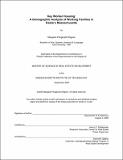| dc.contributor.advisor | Henry O. Pollakowski. | en_US |
| dc.contributor.author | Wagner, Margaret Fitzgerald | en_US |
| dc.contributor.other | Massachusetts Institute of Technology. Dept. of Architecture. | en_US |
| dc.coverage.spatial | n-us-ma | en_US |
| dc.date.accessioned | 2006-06-20T12:55:04Z | |
| dc.date.available | 2006-06-20T12:55:04Z | |
| dc.date.copyright | 2005 | en_US |
| dc.date.issued | 2005 | en_US |
| dc.identifier.uri | http://hdl.handle.net/1721.1/33191 | |
| dc.description | Thesis (S.M.)--Massachusetts Institute of Technology, Dept. of Architecture, 2005. | en_US |
| dc.description | This electronic version was submitted by the student author. The certified thesis is available in the Institute Archives and Special Collections. | en_US |
| dc.description | Includes bibliographical references (leaves 129-132). | en_US |
| dc.description.abstract | As housing costs have soared nationwide, many policy makers have grown increasingly aware of working families' housing needs. Currently, having a full-time job does not guarantee decent and affordable housing. Many housing advocates have speculated that working families have had to move far from their jobs enduring long commutes, less time at home and increased traffic congestion. More specifically, housing advocates worry that key community workers who build and sustain strong communities, like teachers, nurses, firefighters and police officers, cannot live in the communities they serve. This thesis intends to substantiate these claims as they relate to Eastern Massachusetts' "key workers" through a rigorous demographic profiling of a sample of key worker households of those key workers employed in 165 communities. We analyze the key worker household rather than the key worker as an individual through the use of microdata from the 2000 Census. This approach results in an analysis of total household income rather than individual wages when studying housing affordability for key workers employed in Eastern Massachusetts. Our unique analysis produces results and conclusions that vary significantly from previous workforce housing studies. | en_US |
| dc.description.abstract | (cont.) We also are trying to better understand micro demographic details of these key worker households that cannot be understood from the traditional Census data. For example, what differences are seen in housing trends between all workers and key workers? Do key workers tend to rent or to own? How long do these key workers have to commute? Are these key workers the primary wage earners? Into what income bracket do these families fall? Do these key workers live and work in the communities they serve? The hope is that this demographic profiling will aid in quantifying the demand for key worker housing in the Boston area, as well as contribute to the local workforce housing policy debate. | en_US |
| dc.description.statementofresponsibility | by Margaret Fitzgerald Wagner. | en_US |
| dc.format.extent | 132 leaves | en_US |
| dc.format.extent | 2802819 bytes | |
| dc.format.extent | 2802622 bytes | |
| dc.format.mimetype | application/pdf | |
| dc.format.mimetype | application/pdf | |
| dc.language.iso | eng | en_US |
| dc.publisher | Massachusetts Institute of Technology | en_US |
| dc.rights | M.I.T. theses are protected by copyright. They may be viewed from this source for any purpose, but reproduction or distribution in any format is prohibited without written permission. See provided URL for inquiries about permission. | en_US |
| dc.rights.uri | http://dspace.mit.edu/handle/1721.1/7582 | |
| dc.subject | Architecture. | en_US |
| dc.title | Key worker housing : a demographic analysis of working families in eastern Massachusetts | en_US |
| dc.title.alternative | Demographic analysis of working families in eastern Massachusetts | en_US |
| dc.type | Thesis | en_US |
| dc.description.degree | S.M. | en_US |
| dc.contributor.department | Massachusetts Institute of Technology. Department of Architecture | |
| dc.identifier.oclc | 66139605 | en_US |
